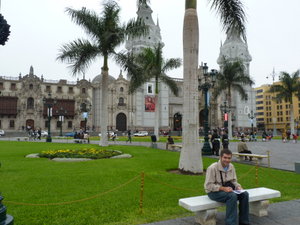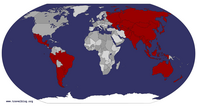Advertisement

 Plaza de Armas, Lima
Plaza de Armas, Lima
The largest colonial plaza in South America.We arrived in Lima and waited patiently for our luggage. As we waited we watched the queue for customs. The process for which consisted of handing over your declaration, then pressing a button which gave a green or red light. The latter meant further checks at a scanner or even opening the bags. It looked random, but we think there was a bloke watching on a monitor deciding who he thought looked shifty or he wanted to frustrate by holding them up a bit longer.
In the meantime, the airline company tried to open the crate containing our luggage. After half an hour or so everyone was handing over their details for luggage to be forwarded, when someone must have decided to get medieval on the tin box and the carousel kicked into life again. Our hotel pick up (bliss) was still waiting for us.
We stayed out at Miraflores rather than in the city, though the old town is lovely - and in general Lima has improved infinitely since Paul's last visit. This may have something to do with the upcoming elections, so the incumbents have spent a bit of public money on roads and repairs in order to

 Cusco
Cusco
Breathtaking ... partly because of the stunning architecture, partly because of the altitude.get another term. But the important thing is they have spent some money and the city is looking better for it.
Unwittingly we found ourselves outside Parliament watching a series of schools put on dance routines. As these finished there was a rush to form a queue outside the building. Being British, the queue was too tempting for us to ignore and we found ourselves being dragged into the building by a guard and left with a tour guide who showed us around the senate and parliament. She was not actually a tour guide, she worked there. She explained that Sundays are the only day you can pitch up and get a free tour without giving up passport and inside leg measurements. She also said the politicians get paid $5000 per year. Perhaps it's not so hard to see why corruption exists if politicians are this lowly paid.
Among several churches and museums on offer in Lima we enjoyed looking around San Francisco convent. The architecture is unusual for a colonial church, the crypts are a little freaky (someone thought it looked good to arrange body parts in concentric circles) but it is the library which is the

 Nic at 4300m
Nic at 4300m
The bike ride started in the freezing cold above the cloud level.most amazing. Its design would be perfect for a Harry Potter film set and it contains 25,000 books some in excess of 400 years old - you can't touch them or they will fall to pieces - but there could be a first edition of The Canterbury Tales in amongst those on display.
On the way down to Cusco we had plenty of delays due to landslides and one sighting of locals trying to salvage a truck upside-down in a river. Our bus may have been late, but it got there.
Now Lima might be improving it's colonial areas and infrastructure, but Cusco is already the real deal. Despite offers of tours, restaurants, taxis, massages and souvenirs every 20 seconds, you would struggle to not love this place. The picture postcard Plaza de Armas, Inca stonework and laid back atmosphere (at 3700m altitude, no-one hurries around here) means it's quite easy to enjoy the lifestyle here. But picture postcard town squares weren't what we came for.
Like most other people travelling in South America we were here to see Machu Picchu. The Inca Trail is off limits to most people these days. Unless you book 6 months

 Jungle trail
Jungle trail
A well deserved restin advance there is little chance of getting one of the limited number of trail permits available per day. However, the tour companies have come up with other ways of getting there, including the Inca Jungle Trail which we took. It does include some jungle trekking and you even spend some time on an Inca path, but if the wet season is in full flow you'll spend most of your time on roads and railway lines.
The first day is all by road, but a lot of fun. The morning is spent collecting the tour group from the hotels (take your pick up time with a very large pinch of salt), breakfasting in Ollyantaytambo, then steadily climbing to 4300m where, in the cloudline and freezing rain you get chucked out of the minibus and on to a mountain bike. It's not too long before you get some good views of the jungle and rivers of the area and your fingers start warming up. It's not too taxing as it is all downhill, the biggest stress is misjudging corners as you really don't want to be leaving the roads here.
After lunch, the trail levels out. There's another hour
cycling then the van whisks you off to your first accommodation in Santa Maria. The following day we find out there was an "old Santa Maria" wiped out by flooding caused during a bad El Nino.
Much of the second morning is spent by the river until we start heading up through the jungle to an Inca Trail. It's a small path because it only linked secondary Inca towns, and the stones are a bit wobbly these days. In fact wobbly enough to send one of our group, David, off the side. He fell about 5ft before hanging on to the foliage and waiting for a helping hand back onto the trail. The afternoon was spent walking on the roads to Santa Teresa, the last hour in the pouring rain - but our rain ponchos stood up to the task. Santa Teresa is also a new town, same reason as Santa Maria.
The last day was spent avoiding the road in the morning. On one occasion this meant taking a precarious looking contraption across the river. After lunch, taken at 10.30am, we walked the railway line to Aguas Calientes. This was pretty easy walking an we only needed

 Machu Picchu at last.
Machu Picchu at last.
10 months waiting, 4 days trekking, 323 photos ... here is just one of them.to jump off the track for one train. From the line we were offered tempting sights of Machu Picchu on the hillside above us.
Day 4 - you can either walk or take the bus. Either way, there are only 400 tickets to climb up Huayna Picchu so its an early start. 3am if you are walking, lie in til 4am if on the bus. We took the bus!
Despite having seen the site on countless photos, we still managed to wear the camera battery down. Every two paces offered a better perspective of what we were seeing. Having bagged one of the tickets to climb Huayna Picchu we felt compelled to do so, despite 30 degree heat. We also went off to see the Inca Bridge (with no details, we can only guess this was a defence for the city - they took away the wooden beams when they didn't want people coming in) and Inti Punku - the Sun Gate. Sure it's busy, it's touristy and getting here is pricey by South American standards ... but it's worth the journey.
Tip - pay for an upgrade to an earlier train than the one the budget

 Pisco Sours all round
Pisco Sours all round
Machu Picchu posse relaxing after 4 hard days.operators offer. We were back in Cusco at 2am - very tired after a 4am start.
Back in Cusco we slept for most of the next day but managed to stagger to the pub to meet up with the group for a few celebratory drinks at Indigo bar, our favoured drinking venue in Cusco, mainly due to the extended happy hour and great Pisco Sours.
We could have easily passed the rest of our time in Peru rooted in Cusco. 9 months traveling and you yearn to lay your hat for more than a few days when you find somewhere you like, but we overcame the fatigue by adding another country to the list of those visited on this trip with an unexpected detour into Bolivia. Originally we intended to see Lake Titicaca from Puno in Peru, but others suggested Copacabana is a better base. It also offers access to Isla de Sol, the birthplace of the Inca legends.
The only drawback was that the direct bus was actually 3 buses and took a couple of hours longer than expected, but it was worth taking the advice as Copacabana is laid back by tourist town standards. It

 Isla de Sol
Isla de Sol
The birthplace of the Incas.also has lovely little trout "restaurants" along the lake shore - all selling their famous fish, only the beer price varies - and we hadn't had fish and chips for ages.
Isla de Sol is a strange place. It has a northern town and archaeological sites, a southern town and archaeological sites and a path that joins them. We paid separately to go into the north, then to use the path, then get into the south in order to get the boat back - in theory. We'd run out of local currency by the time we got to the southern town, so we told them we would close our eyes when we got near the Inca sites and barged on past.
Our bus journey back to Lima via Puno was due to take 24 hours, which gave us 2 hours slack in the schedule in which to get our plane. You may recall we cut a train journey a bit fine in Chengdu, China and then a bus journey a bit fine forgetting we'd lost an hour when crossing the border into Argentina ... well 3rd time unlucky. The bus was 2 1/2 hours late, the traffic was chronic and LAN kindly told us they "close check in 1 hour before departure and there was only 40 minutes before departure". Adding, for what point we don't know, "you're late". No shit Sherlock, can we bend the rules?
No rule bending allowed, but there was a later flight to Quito with space. So just an extra 6 hours sitting in an airport. Owing to travel connections and cancellations we now think we've given up 2 days of our travel time just sitting in airports. Whoever said it is better to travel than to arrive obviously said it before air travel.
Advertisement
Tot: 0.127s; Tpl: 0.012s; cc: 15; qc: 58; dbt: 0.0549s; 1; m:domysql w:travelblog (10.17.0.13); sld: 1;
; mem: 1.2mb









